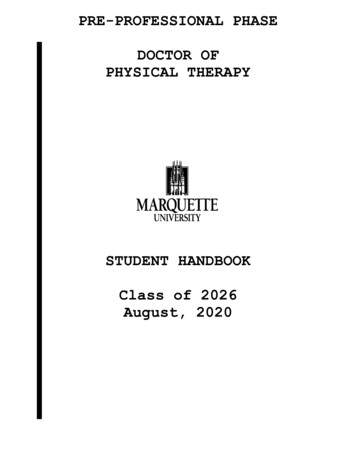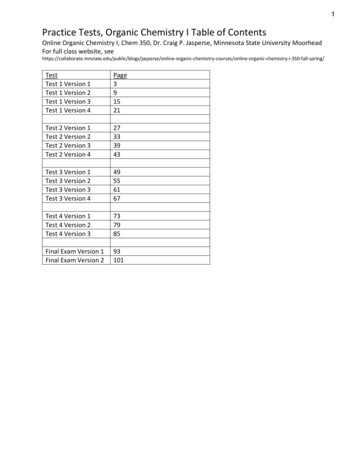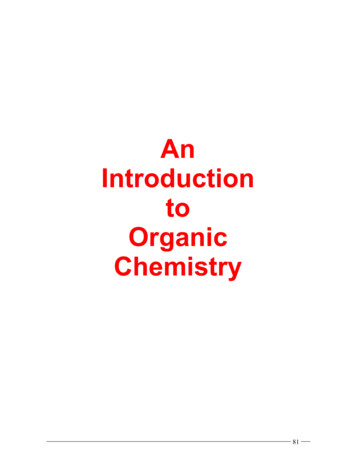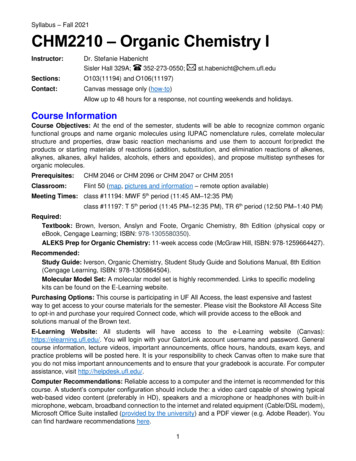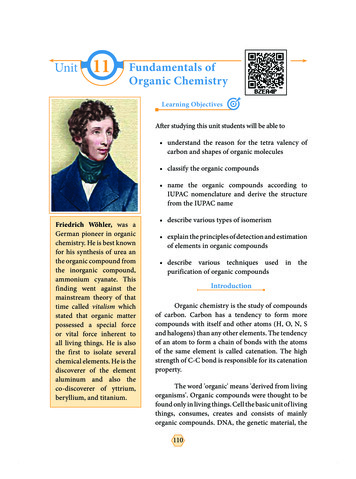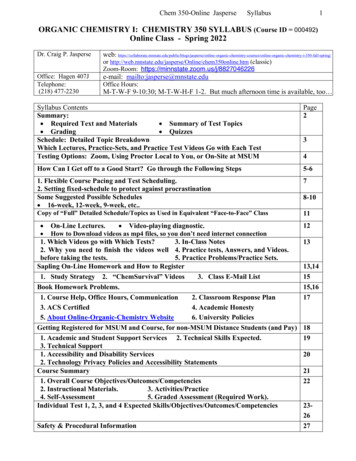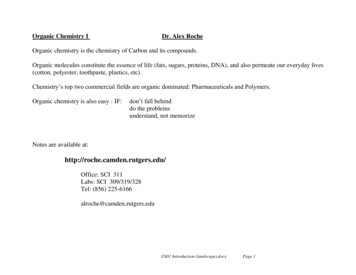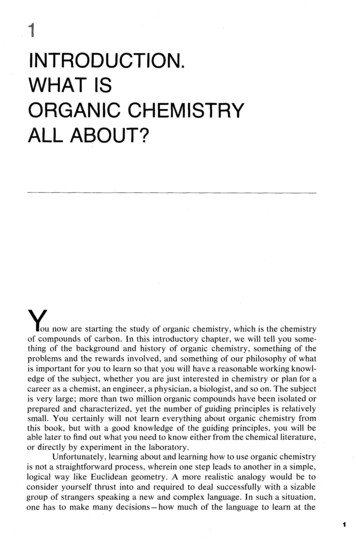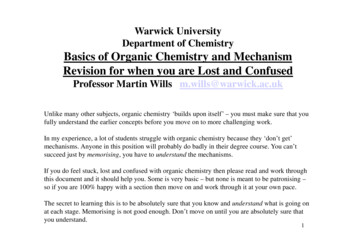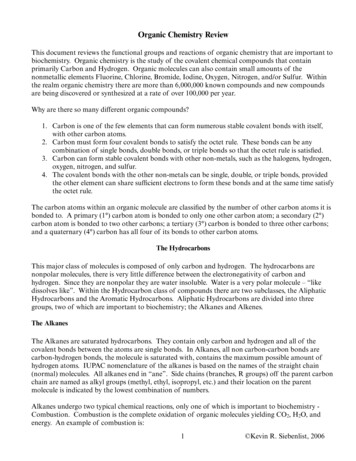
Transcription
Organic Chemistry ReviewThis document reviews the functional groups and reactions of organic chemistry that are important tobiochemistry. Organic chemistry is the study of the covalent chemical compounds that containprimarily Carbon and Hydrogen. Organic molecules can also contain small amounts of thenonmetallic elements Fluorine, Chlorine, Bromide, Iodine, Oxygen, Nitrogen, and/or Sulfur. Withinthe realm organic chemistry there are more than 6,000,000 known compounds and new compoundsare being discovered or synthesized at a rate of over 100,000 per year.Why are there so many different organic compounds?1. Carbon is one of the few elements that can form numerous stable covalent bonds with itself,with other carbon atoms.2. Carbon must form four covalent bonds to satisfy the octet rule. These bonds can be anycombination of single bonds, double bonds, or triple bonds so that the octet rule is satisfied.3. Carbon can form stable covalent bonds with other non-metals, such as the halogens, hydrogen,oxygen, nitrogen, and sulfur.4. The covalent bonds with the other non-metals can be single, double, or triple bonds, providedthe other element can share sufficient electrons to form these bonds and at the same time satisfythe octet rule.The carbon atoms within an organic molecule are classified by the number of other carbon atoms it isbonded to. A primary (1 ) carbon atom is bonded to only one other carbon atom; a secondary (2 )carbon atom is bonded to two other carbons; a tertiary (3 ) carbon is bonded to three other carbons;and a quaternary (4 ) carbon has all four of its bonds to other carbon atoms.The HydrocarbonsThis major class of molecules is composed of only carbon and hydrogen. The hydrocarbons arenonpolar molecules, there is very little difference between the electronegativity of carbon andhydrogen. Since they are nonpolar they are water insoluble. Water is a very polar molecule – “likedissolves like”. Within the Hydrocarbon class of compounds there are two subclasses, the AliphaticHydrocarbons and the Aromatic Hydrocarbons. Aliphatic Hydrocarbons are divided into threegroups, two of which are important to biochemistry; the Alkanes and Alkenes.The AlkanesThe Alkanes are saturated hydrocarbons. They contain only carbon and hydrogen and all of thecovalent bonds between the atoms are single bonds. In Alkanes, all non carbon-carbon bonds arecarbon-hydrogen bonds, the molecule is saturated with, contains the maximum possible amount ofhydrogen atoms. IUPAC nomenclature of the alkanes is based on the names of the straight chain(normal) molecules. All alkanes end in “ane”. Side chains (branches, R groups) off the parent carbonchain are named as alkyl groups (methyl, ethyl, isopropyl, etc.) and their location on the parentmolecule is indicated by the lowest combination of numbers.Alkanes undergo two typical chemical reactions, only one of which is important to biochemistry Combustion. Combustion is the complete oxidation of organic molecules yielding CO2, H2O, andenergy. An example of combustion is:1 Kevin R. Siebenlist, 2006
CH4 2 O2 CO2 H2O 213 kcalAll organic molecules can undergo combustion reactions.The AlkenesThe Alkenes are unsaturated hydrocarbons. They contain carbon and hydrogen and one or morecarbon-carbon double bonds (less than a saturating amount of hydrogen). IUPAC nomenclature forthe alkenes is similar to that of the alkanes except the names of the alkenes all end in “ene” and theposition of the carbon-carbon double bond is given the lowest possible number. Since carbon-carbondouble bonds are not free to rotate, the alkenes exhibit a form of Stereoisomerism called GeometricIsomerism or Cis-Trans Isomerism. Cis-Trans Isomers contain the same alkyl side chains (functionalgroups), but their arrangement around the carbon-carbon double bond, their geometry, is different.General ��trans”XA“trans”Specific Examples:HHCHCH3CCH3CCH3CH3 C“cis”HHCHCH3 C“trans”HBrCBrCH3 C“cis”H“trans”Alkenes undergo Addition Reactions. Molecules of the type XY add across the double bond. X addsto one of the carbons of the double bond, Y goes to the other, and the double bond is reduced to asingle bond. The molecule XY can be H2, Cl2, Br2, HCl, HBr, or H2O.General Reaction:CC X YCCXYSpecific Examples:2 Kevin R. Siebenlist, 2006
HHC CHHHHCH CH2HH2OHHHHCCHHHHHCCHOHHAdding H2 across a double bond is called hydrogenation; adding Cl2 or Br2 across the double bond istermed halogenation; adding HCl or HBr is called hydrohalogenation; and adding H2O across adouble bond is termed hydration. Hydrogenation and hydration of carbon-carbon double bondsoccurs in biological systems.Alkenes also undergo addition reactions between themselves. In the presence of an appropriatecatalyst alkenes will add to themselves resulting in the formation of addition polymers. Polyethylene,polypropylene, polyvinyl-chloride (PVC), and Teflon are all examples of alkene addition polymers.The Aromatic HydrocarbonsAromatic Hydrocarbons are based upon the molecule Benzene.Aromatic molecules contain 6 or more delocalized π (Pi) electrons that are shared equally by allmember atoms of the ring. This delocalization of electrons over the entire ring results in a very stablemolecule. Aromatic hydrocarbons do not undergo addition reactions because this type of reactionwould destroy the stable configuration of π electrons. Rather they take part in Substitution Reactions,where one or more of the hydrogens on the ring is replaced by a different element or functional group.The Oxygen Containing Organic CompoundsThe AlcoholsThe alcohols contain one or more Hydroxyl groups; –OHGeneral Structure:R1R2COHR33 Kevin R. Siebenlist, 2006
where R1, R2, and R3 can be hydrogen or an alkyl group. Alcohol nomenclature is based upon thenomenclature of the alkanes, with two changes/additions. The “e” of the name of the parent alkane isdropped and “ol” is added in its place (ethane ethanol) and the hydroxyl functional group is giventhe lowest possible number (or set of numbers).Alcohols are polar molecules because oxygen is much more electronegative than carbon or hydrogen.In an alcohol, the oxygen has a partial negative charge (δ–); the carbon and hydrogen of the alcoholgroup have a partial positive charge (δ ). Since alcohols are polar the smaller alcohols (6 or fewercarbons) are water soluble.H 3CH2CH 3CHCCH 3CH 3H 3COHOH1 CCH 3OH2 3 If the hydroxyl group of an alcohol is attached to a carbon atom that is bonded to zero or one othercarbon atom the resulting molecule is termed a primary (1 ) alcohol (see above). If the hydroxyl groupis bonded to a carbon that is covalently linked to two other carbon atoms it is a secondary (2 ) alcohol.A tertiary (3 ) alcohol has the hydroxyl group attached to a carbon that is covalently bonded to threeother carbons. The chemistry of 1 , 2 , and 3 alcohols varies.Alcohols undergo two types of reactions important to biochemistry. Alcohol molecules undergoDehydration Reactions and the hydroxyl group of an alcohol can be Oxidized.Dehydration ReactionsIn a Dehydration Reaction a molecule of water is removed from the reacting species. Depending uponthe reaction conditions, alcohols are dehydrated either by an Intermolecular or an Intramolecularreaction mechanism. In the laboratory, in vitro, both reactions require an acid catalyst and hightemperatures. Intermolecular dehydration reactions occur at a lower temperature and the watermolecule is removed from between two reacting alcohol molecules. The product of an intermolecularalcohol dehydration reaction is an EtherGeneral Reaction:R1H2COH140 C HOH2CR2 HOH2CCH3H2SO4R1H2CH2COR2 H 2OSpecific Example:H3 CH2COH140 CH2SO4H3CH2COH2CCH3 H 2OIntramolecular dehydration reactions require a higher temperature to proceed and the water molecule4 Kevin R. Siebenlist, 2006
is removed from within a single alcohol molecule. The product of an intramolecular alcoholdehydration reaction is an Alkene.General Reaction:H2CR1HC170 CR2R1H2SO4OHCHCHR2 H 2OSpecific Example:H3 CH2CHCH2CH2CH3C170 CCH3H2CCHH2CCH3 H2SO4OHCHH3 CH2CCH H 2OCHH2CCH3Biological systems are capable of dehydrating alcohols to form ethers or alkenes. However, cells mustand do employ significantly milder conditions.Oxidation ReactionWhen an alcohol undergoes oxidation, the hydroxyl group is oxidized to a carbonyl group, C O.During an oxidation reaction, electrons are lost from the reacting species. In organic chemistry andbiochemistry the loss of electrons is usually accompanied by a loss of hydrogen atoms or a gain ofoxygen atoms. The oxidation of an alcohol results in the loss of two hydrogen atoms, one from thehydroxyl group and the second from the carbon atom carrying the hydroxyl group. The product of thereaction depends upon the type of alcohol oxidized. Primary alcohols yield Aldehydes; secondaryalcohols produce Ketones; tertiary alcohols cannot be oxidized without breaking carbon-carbonbonds.General Reaction:H2CR1OH1 OHO[O]CHCR1HR1O[O]AldehydeCR1R22 R2KetoneOHR1C[O]R3No RxnR23 5 Kevin R. Siebenlist, 2006
Specific Examples:OHOH2CH3 C[O]OH1 [O]CHCH3COHH3 CCH3AldehydeCH3 C2 CH3KetoneThe EthersEthers all contain the ether functional group, C–O–C, two organic groups (two alkyl, two aromatic, orone of each) bonded to an oxygen atom.CH 3H2CH2CH 3COCH2H 2CCH 3CH 2OOEthersThey are formed by the intermolecular dehydration of alcohols. Ethers are polar molecules, oxygen ismore electronegative than carbon. Ethers are less polar than alcohols and therefore they are less watersoluble than alcohols. Ethers are formed in biological systems and once formed they are relativelyinert.The Aldehydes and KetonesThe aldehydes and ketones are treated together because they both contain the carbonyl functionalgroup, C O, and therefore their chemistries are similar. An aldehyde contains the carbonyl group asthe terminal carbon, carbon 1, whereas, ketones have the carbonyl group on an interior carbon (notcarbon 1).OOCH3CCHH3 CAldehydeCH3KetoneAldehydes are named by dropping the “e” from the name of the parent alkane and adding “al” in itsplace (ethane ethanal). The carbon atom carrying the carbonyl group is always carbon 1 of thealdehyde and the other functional groups on the molecule are numbered from this starting point.Ketones are named by dropping the “e” from the name of the parent alkane and adding “one” in itsplace (propane propanone). The carbon atom carrying the carbonyl group in the ketone is giventhe lowest possible number and the other functional groups are numbered accordingly, i.e., given the6 Kevin R. Siebenlist, 2006
lowest possible set of numbers. The carbonyl group takes precedence over the other functional groupsdiscussed so far.Aldehydes and Ketones are polar molecules, oxygen is more electronegative than carbon. Aldehydesand Ketones are less polar than alcohols, but more polar than ethers. Their solubility in water is lessthan that of alcohols, but greater than that of ethers.The chemistry of aldehydes and ketones is possibly the most complex in the realm of organicchemistry. Aldehydes can be oxidized. Aldehydes and ketones can be reduced, they can react withalcohols, and they can react with each other.Oxidation ReactionWhen aldehydes are oxidized the carbonyl group is converted to a Carboxylic Acid group, –COOH.This oxidation is accompanied by the addition of an oxygen (–OH) to the carbonyl carbon. Aldehydesare easily oxidized. Metal ions such as Ag and Cu2 at room temperature can act as oxidizing agents.When silver ion is the oxidizing agent, it is reduced to metallic silver forming a silver mirror on thereaction vessel. Oxidation of aldehydes by Ag is the Tollen’s Test or Tollen’s Reaction. When Cu2 isthe oxidizing agent, it is reduced to Cu2O, a brick red water insoluble compound (precipitate). Theoxidation of aldehydes by Cu2 is the Benedict’s Test. These two reactions are used as simple tests foraldehydes.O[O]CR1H3CCR1HOOOOHCCH2HGeneral Rxn[O]H3CCCH2OHSpecific ExampleReduction ReactionWhen aldehydes and ketones are reduced the corresponding alcohols are produced. During areduction reaction electrons are gained by the reacting species. In organic chemistry and biochemistrythe gain of electrons is often accompanied by the gain of hydrogen or the loss of oxygen. In thereduction of aldehydes and ketones, the carbonyl oxygen and the carbonyl carbon each gain ahydrogen. The reduction of an aldehyde produces a 1 alcohol; the reduction of a ketone produces a2 alcohol.General Reaction:OO[H]CR1H2CHR1OH[H]COHR1R2R1CHR2Specific Examples:7 Kevin R. Siebenlist, 2006
OHOOH2C[H]CH3 CHH3 CH3COHCCH2H3C[H]CH3CHCH2CH3Reaction with Alcohols (An Addition Reaction)Aldehydes and ketones undergo Addition Reactions. Alcohols react with aldehydes and ketones by anaddition reaction. The products of the addition reaction between equal molar amounts of aldehydesand alcohols are Hemiacetals, whereas, the product formed from equal molar amounts of ketones andalcohols are known as Hemiketals. Mechanistically, in the presence of an acid catalyst and a smallamount of heat, the partially negatively charged hydroxyl oxygen of the alcohol attacks the partiallypositively charged carbonyl carbon of the aldehyde or ketone and the partially negatively chargedcarbonyl oxygen attacks the partially positively charged hydroxyl hydrogen. The alcohol is addedacross the carbon-oxygen double bond of the carbonyl group.H – OOH HH2SO4O –RC CORGeneral Reaction:O CR1HHOO CR1R2R3R1 OHH2SO4H2CHOOHH2SO4H2CR1 HCR2Specific Examples:O CH3 CHHOOHH2SO4H2CCH3H3C HCHemiacetalHOHOH3CCCH2CH3 H2CHOCH2CH3H2SO4H3CCCH2 HCH3HemiketalCH38 Kevin R. Siebenlist, 2006
Hemiacetals are recognized by finding an ether linkage (C-O-C) where one of the carbons of the etherlinkage also carries a –OH and a –H. The hemiketal is an ether linkage where one of the carbonsinvolved in the ether linkage also carries a –OH and an organic (–R) group {see above}.Hemiacetals and hemiketals are very reactive compounds. Only a very few hemiacetals and/orhemiketals can be isolated in pure form. Usually they rapidly revert to the starting materials (re)establishing an equilibrium. The hydroxyl (-OH) group that is part of the hemiacetal or hemiketalfunctional group is a very reactive chemical group. It is much more reactive than the hydroxyl groupsof simple alcohols. The hydroxyl group of hemiacetals and hemiketals will rapidly react with anotheralcohol molecule or with any excess alcohol molecules to form Acetals and Ketals, respectively. Thisreaction between hemiacetals or hemiketals and alcohols is a dehydration reaction. An acetalfunctional group has the following appearance:R2R1H2COCOH2CR3HIt is a diether (C-O-C-O-C) with a organic (–R) group and an –H attached to the middle carbon of thediether. The R group on the middle carbon is the carbon chain of the original aldehyde.A ketal functional group has the following appearance:R3R1H2COCOH2CR4R2It is a diether (C-O-C-O-C) with two organic (–R) groups attached to the middle carbon of the diether.The R groups bonded to the middle carbon are the carbon chains of the original ketone.General Reaction:H2 COHR1CH2COR2 H2SO4H2CHOR4 HHR4OR1CH2COR2AcetalHH2 COHR1CR2OH2CR3 H2SO4H2CHOR4 HR4OR1COH2CR3KetalR29 Kevin R. Siebenlist, 2006
Specific Examples:OHH3CH2CH2 CCH2COCH3 H2CHOCH2HCH3H2SO4CH3O HH3CCOH2CAcetalCH3HH2 COHH3CCOH2CH2CCH3CH2 H2CH2CHOCH2H2CCH3OH2SO4CH3H2CH3C HCH2COH2CCH3KetalCH2CH3CH3Acetal and ketals can be synthesized in two steps as outlined above (aldehyde or ketone alcohol hemiacetal or hemiketal alcohol acetals or ketals), or they can be formed in a single step(aldehyde or ketone 2 molar excess alcohol acetal or ketal).Acetals and ketals are more stable than hemiacetals and hemiketals, many can be isolated in pureform. However, in the presence of an acid or other suitable catalyst and H2O they are rapidly brokendown into the starting materials; an aldehyde or a ketone and two alcohols.Reaction with Other Aldehydes or Ketones (an Addition Reaction / The Aldol Condensation)When aldehydes and/or ketones react with each other the carbon adjacent to the carbonyl carbon onone molecule attacks the carbonyl carbon of the second. This reaction forms new carbon-carbonbonds. The reaction is called an Aldol Condensation.General Reaction:OR1H2CCR2 OR3H2CCatalystCH2CR1R4OH R3CCR2HOCR4Specific Examples:O CH3 COHOHH3CCHCatalystCH3 CH10O2 AldehydesCCH2H Kevin R. Siebenlist, 2006
OOO CH3 COHCH3H3CCCatalystCH3 CCH3CCH3CH3 CH3 CHOOCH3CHCH2CCH3HOHH2CCatalystCH3CH3 2 KetonesCH2H3C CH2OOH2CAn Aldehyde & A KetoneCH2OHH2C CCH3 CCH2CCCOHCH3CH3OHCarboxylic AcidsCarboxylic acids contain one or more Carboxyl functional groups; –COOH. Their general structureis:ORCOHCarboxylic acids are very polar molecules, oxygen is more electronegative than carbon and there aretwo oxygen atoms attached to a single carbon atom. Carboxylic acids are considerably more polar andmore water soluble than alcohols.Carboxylic acids are weak acids. The simple alkyl carboxylic acids have pKa’s in the range of 3 to 9.When dissolved in water carboxylic acids establish equilibria with their corresponding CarboxylateAnions.OR COHOH OHHOHHRCOWhen naming a carboxylic acid, the “e” from the name of the parent alkane is dropped and the ending"oic acid" is added (propane propanoic acid). The name of the corresponding carboxylate anion isformed by dropping the “ic acid” ending and adding "ate" in its place (propanoic acid propanoate).The carboxylic acid group is always carbon 1 in the numbering scheme, it takes precedence over allother organic functional groups because it is the most oxidized.Carboxylic acids undergo Neutralization reactions, Reduction reactions, and Dehydration reactions.The Neutralization ReactionCarboxylic acids are neutralized by bases forming Carboxylate Salts. These salts are true ionic11 Kevin R. Siebenlist, 2006
compounds and therefore are very polar and very water soluble.The Reduction ReactionWhen carboxylic acids undergo reduction with an equal molar amount of reducing agent the productis the corresponding aldehyde.General ReactionORC[H]ORCOHHWhen an excess of reducing agent is employed in the reaction, the carboxylic acid is reduced all theway back to the corresponding 1 alcohol.General ReactionORCH2C[xsH]ROHOHThe Dehydration ReactionsCarboxylic acids react with alcohols, ammonia, and oxygen containing acids (oxiacids; e.g., sulfuricacid or phosphoric acid) via dehydration reactions.with AlcoholsWhen carboxylic acids react with alcohols the product is an EsterGeneral Reaction:OR COHH2CR2OCatalystOHDehydrationAgentH2CCRO H 2OR2Specific Example:OH3C COHH2CH3 COHCatalystODehydrationAgentCH3CH2CO H 2OCH3with AmmoniaWhen carboxylic acids react with ammonia the product is an Amide12 Kevin R. Siebenlist, 2006
General ehydrationAgentC CNH3 RH 2ONH2Specific Example:H3C CNH3OH H3CH 2ONH2with OxiacidsWhen carboxylic acids react with other oxygen containing acids the product is an Acid Anhydride. Ifthe dehydration reaction is between two organic acids (two carboxylic acids) the product is an OrganicAcid Anhydride or a Carboxylic Acid Anhydride. If the reaction is between an organic acid and aninorganic oxiacid the product is a Mixed Acid Anhydride.O CROHCatalystOOCDehydrationAgentCCHOR CHOOHPR OH 2OROOOROCatalystOHOHOCDehydrationAgentROP OHH2OOHOxygen containing mineral acids, especially phosphoric and sulfuric acids, undergo similardehydration reactions to produce phosphoric acid anhydrides and sulfuric acid anhydrides.General Reaction:OOHOPOH HOOHPOCatalystOHOHDehydrationAgentHOPOOOHPOH H 2OOHDiphosphate(Pyrophosphate)OHOPOHOOPOHOOH HOPOHOCatalystOHDehydrationAgentHOPOHOOPOOOHPOH H 2OOHTriphosphate13 Kevin R. Siebenlist, 2006
Acid anhydrides are unstable high energy compounds. When water is added back to an acid anhydridethe corresponding acids are formed and a large quantity of energy (heat) is liberated.The EstersEsters are formed by the dehydration reaction between carboxylic acids and alcohols. All esters havethe following general structure:OR1R2COCR3R4R1, R2, R3, & R4 can be hydrogens, alkyl groups, and/or aromatic groups. Esters are named by namingthe carbon chain of the reactant alcohol, followed by the name of the carboxylate anion involved inthe reaction.Esters, like the carboxylic acids and alcohols used for their synthesis, are polar molecules. They aremore polar than alcohols but less polar than carboxylic acids.Esters undergo Hydrolysis Reactions catalyzed by either strong acids or strong bases. When an ester ishydrolyzed in the presence of a strong acid the product is the corresponding carboxylic acid andalcohol.General Reaction:OR1OCR2OR2CR3 H2OAcidR1 CHOOHCR3R4R4Specific Example:OH3 COCCH3OCH3CH2CCH3 H2OAcidH3C COHHHOCH2CCH3HWhen an ester is hydrolyzed in the presence of a strong base the product is the corresponding salt ofthe carboxylate anion and an alcohol. During base catalyzed hydrolysis of an ester, as fast as thecarboxylic acid forms it is neutralized by the base present in the reaction mixture to form the salt; acid base salt The base catalyzed hydrolysis of an ester is called Saponification (Soap Forming). Saltsof long chain ( 8 C) carboxylic acids (carboxylate anions) are soaps.14 Kevin R. Siebenlist, 2006
General Reaction:OR1OCR2OR2C R3H2OBaseR1 CHOOCR3R4R4Specific Example:OH3 COCCH3OCH3CH2CCH3 H2OBaseH3C CHOOCH2CCH3HHThe Nitrogen Containing Organic CompoundsThe AminesAmines can be considered as organic derivatives of ammonia. They all have the following generalstructure:R1NR3R2Specific Examples:CH3CH3NNHCH3HH1 HCH3H3C2 CH33 Amines are classified as primary, secondary, or tertiary according to how many organic substituentsare bonded to the nitrogen atom. A primary amine has one organic group bonded to the nitrogen, asecondary amine has two organic groups, and a tertiary has three. When a fourth organic group bondsto the nitrogen through the unshared pair of electrons on the nitrogen, the compound is a QuaternaryAmmonium Ion, which has a positive charge and forms ionic compounds with anions.CH3H3 CNCH3CH3Amines are polar molecules because nitrogen is much more electronegative than carbon or hydrogen.15 Kevin R. Siebenlist, 2006
In an amine, the nitrogen has a partial negative charge (δ–); the carbon and/or hydrogen have a partialpositive charge (δ ). Since they are polar molecules they are water soluble. Nitrogen is lesselectronegative than oxygen therefore amines are less polar than the oxygen containing organicmolecules.Amines are weak bases, they will accept a proton (H ) from water or acids when dissolved in water.Specific Example:H2CH3C NH2H2CH 2OH3 C NH3OH–When an amine accepts a proton from water the product is an Ammonium Cation. The pKa’s ofamines range from 7 to 12.Since amines are weak bases, they undergo neutralization reactions with acids to form AlkylAmmonium Salts. These salts are true ionic compounds and therefore are very polar and very watersoluble.H2CH3C NH2H2CHClH3 CNH3 Cl–Primary and secondary amines undergo Dehydration Reactions with carboxylic acids. This reaction isidentical to the reaction of ammonia with carboxylic acids. The product of the reaction is an Amide.General Reaction:R1OR2CatalystOHR3DehydrationAgentOH2 CCH3O CHNR1CNR2 H 2OAmideR3Specific Example:H3 CH2C COHHNCH3CatalystH3 CH2COCDehydrationAgentNH3CH2CCH3 H 2OAmideThe AmidesAmides are formed by the dehydration reaction between carboxylic acids and amines. The amidefunctional group is as follows:16 Kevin R. Siebenlist, 2006
OR1CNR2R3Amides are polar compounds since nitrogen and oxygen are more electronegative than carbon andhydrogen. Amides are very water soluble.Amides undergo Hydrolysis Reactions. The hydrolysis reaction can be catalyzed by strong acids orstrong bases. When the hydrolysis reaction is catalyzed by a strong acid the product is thecorresponding carboxylic acid and alkyl ammonium salt. During the reaction water is added acrossthe amide bond to break the bond. As fast as the amine forms it is neutralized by the acid present inthe reaction mixture to form the salt. The anion of the salt is the anion of the acid used for hydrolysis.General Reaction:OR1OCNR2 H 2OAcidR1R2R3OHR3H2 N CSpecific Example:H3 CH2COCNH2CCH3 H 2OAcidH3 CH2CO CH2CCH3H3COHH3CH2 NWhen the hydrolysis reaction is catalyzed by a strong base the product is the correspondingcarboxylate salt and the amine. During the reaction water is added across the amide bond to break thebond. As fast as the carboxylic acid forms it is neutralized by the base present in the reaction mixtureto form the salt. The cation of the salt is the cation of the base used for the reaction.General Reaction:OR1OBaseCNR2 H 2OR1 COR3HNR2R3Specific Example:17 Kevin R. Siebenlist, 2006
H3 CH2COCH2CNCH3 H 2OOH2CBaseH3 CHN CCH3H3COH3CH2CThe Sulfur Containing Organic CompoundsThe ThiolsThiols contain one or more Sulfhydral Groups, –SH. This group of compounds is also calledMercaptans. Thiols are named by using the prefix “thiol” preceded by a number to indicate itsposition on the carbon chain. Thiols are slightly polar molecules since there is a small differencebetween the electronegativities of sulfur and carbon. They are slightly water soluble. The chemistry ofthiols is very similar to the chemistry of alcohols because sulfur and oxygen occupy the same group inthe periodic table. Thiols can be Desulfated, Oxidized, and they react with carboxylic acids to formThioesters.Desulfation ReactionThis reaction is similar to the intermolecular dehydration reaction of alcohols. The product of thisreaction is a Thioether.General Reaction:H2CR1SH H2CHSH2CCatalystR1R1H2CSR1 H2SSpecific Example:H2CH3 CSH H2CHSH3CCH3H2CH2CCatalystSCH3 H2SThioethers are fairly stable compounds and relatively unreactive. They can be oxidized by strongoxidizing agents.Oxidation Reaction of ThiolsThiols can be oxidized by mild oxidizing agents such as O2 to form Disulfides, -S-S-. Disulfides, onceformed, are easily reduced to (re)form the corresponding Thiols.General Reaction:H2CRSH HSH2C[O]H2CR[H]18RSSRCH2 Kevin R. Siebenlist, 2006
Specific Example:H2CH3 C SH[O]H2CHSCH3H2CH3C[H]SSCH2CH3Thioester FormationThiols react with carboxylic acids to form Thioesters via a dehydration reaction.General Reaction:OR1 COHOCatalystH2CR1DehydrationAgentRHSCSH2C H 2ORSpecific Example:H3 CH2CO COHCatalystH2CHSH3 CDehydrationAgentCH3H2COCSH2C H 2OCH3Thioesters are high energy compounds. When these compounds are hydrolyzed, when water is addedback across the thioester bond, the corresponding carboxylic acid and thiol are formed and a largeamount of energy (heat) is liberated.Stereoisomerism and Molecular SymmetrySymmetry is defined as a correspondence in size, shape, and relative position of parts that are onopposite sides of a dividing line or plane.Several types of isomers are encountered in organic chemistry. The first type is the constitutional orstructural isomer. Constitutional isomers have identical empirical formulas but different structures.The atoms making up the molecule are arranged as different side chains or into different functionalgroups. For example:CH3H2CH3CCH2CH3&CHH3 CCH3are constitutional isomers, as are:H2CH3 COH&19OH3 CCH3 Kevin R. Siebenlist, 2006
The second major type of isomer are the stereoisomers. These molecules have the same empiricalformula and the same functional groups but the groups are arranged differently in space. One subsetof the stereoisomers are the geometric or “cis-trans” isomers. In the geometric isomers the differentgroups are arranged differently around a carbon-carbon double bond. An example of a “cis-trans”isomer pair is:H3 CCH3CHHCC&H2 CH3CCH3CH3CH2CCH3The second subset of the stereoisomers are the optical isomers. This subset of the stereoisomers sharesa common physical property, they all rotate plane polarized light. Hence the name - optical isomers.There are several different groups in the optical isomer subset. The largest subset of the opticalisomers is the Enantiomers. Optical isomers also include the Diastereomers and Meso IsomersDiastereomersMesoCompoundsBefore enantiomers are discussed at a chemical level an easily visualized example will be explored.Look at your right hand. It has a central region, the palm, and attached to this central region are 5different groups, the five fingers. Your right hand is asymmetric, since the groups (fingers) on oppositesides of a line dividing your hand in half are different. Now look at your left hand. It also has acentral region with five different groups attached. The five fingers on your right hand are for the mostpart identical to the five fingers on your left hand. However, the fingers are arranged such that yourtwo hands are different. If you were to hold your right hand up to mirror the reflection would lookexactly like your left hand. Similarly, the mirror image of your left hand looks like your right hand.Your two hands are mirror images of each other. Furthermore, your two hands are nonsuperimposable. You cannot lay one hand on top of the other and have your fingers line up with eachother. Your hands are asymmetric, non-superimposable, mirror images of each other.20 Kevin R. Siebenlist, 2006
Now look at these two molecules (models).The first molecule has a central carbon atom with four different groups attached to it. The secondmolecule also has a central carbon atom with the same four groups attached, but the four groups areattached to the central atom in a different arrangement. The configuration of groups around thecentral atom is different. These molecules are Stereoisomers. They have the same empirical formulaand the same functional groups, but the groups are arranged in space differently. The groups arearranged such that
Organic Chemistry Review This document reviews the functional groups and reactions of organic chemistry that are important to biochemistry. Organic chemistry is the study of the covalent chemical compounds that contain primarily Carbon and Hydrogen

